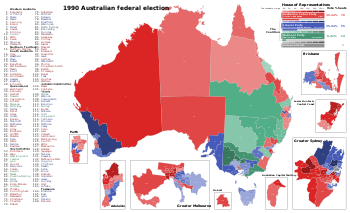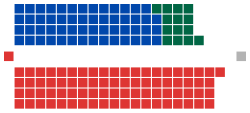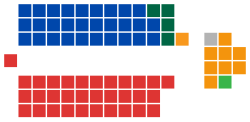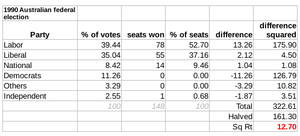| |||||||||||||||||||||||||||||||||||||||||||||||||||||||||
| ← outgoing memberselected members → | |||||||||||||||||||||||||||||||||||||||||||||||||||||||||
All 148 seats in the House of Representatives 75 seats were needed for a majority in the House 40 (of the 76) seats in the Senate | |||||||||||||||||||||||||||||||||||||||||||||||||||||||||
|---|---|---|---|---|---|---|---|---|---|---|---|---|---|---|---|---|---|---|---|---|---|---|---|---|---|---|---|---|---|---|---|---|---|---|---|---|---|---|---|---|---|---|---|---|---|---|---|---|---|---|---|---|---|---|---|---|---|
| Registered | 10,728,435 | ||||||||||||||||||||||||||||||||||||||||||||||||||||||||
| Turnout | 10,225,800 (95.31%) ( | ||||||||||||||||||||||||||||||||||||||||||||||||||||||||
| |||||||||||||||||||||||||||||||||||||||||||||||||||||||||
 Results by division for the House of Representatives, shaded by winning party's margin of victory. Results by division for the House of Representatives, shaded by winning party's margin of victory. | |||||||||||||||||||||||||||||||||||||||||||||||||||||||||
| |||||||||||||||||||||||||||||||||||||||||||||||||||||||||
1990 Australian federal election |
|---|
| National results |
| State and territory results |
|
|
The 1990 Australian federal election was held in Australia on 24 March 1990. All 148 seats in the House of Representatives and 40 seats in the 76-member Senate were up for election. The incumbent Australian Labor Party, led by Bob Hawke, defeated the opposition Liberal Party of Australia, led by Andrew Peacock, with its coalition partner, the National Party of Australia, led by Charles Blunt, despite losing the nationwide popular and two-party-preferred vote. The result saw the re-election of the Hawke government for a fourth successive term, the first time the ALP had won four consecutive terms.
Background
After John Howard lost the 1987 election to Hawke, Andrew Peacock was elected Deputy Leader in a show of party unity. In May 1989, Peacock's supporters mounted a successful leadership challenge which returned Peacock to the leadership. Hawke's Treasurer, Keating, ridiculed Peacock by asking: "Can the soufflé rise twice?" and calling him, in reference to Peacock's name, "all feathers and no meat".
Hawke's government was in political trouble, with high interest rates and a financial crisis in Victoria. The controversy over the Multifunction Polis boiled over during the federal election campaign. Peacock, declared that a future Coalition Government would abandon the project. He shared the Asian "enclave" fears of RSL president Alf Garland and others. The following day, The Australian newspaper ran a headline "Peacock a 'danger in the Lodge'".
In February 1990, the Liberal Party's deputy Senate leader Austin Lewis was sacked from shadow cabinet after suggesting Peacock would be removed as leader if the Coalition failed to win the election. Lewis's comments reportedly reignited leadership tensions within the Liberal Party and were influential in Hawke deciding to set an election date in March, two months before the last possible date for the election.
Opinion polling
| Date | Brand | Primary vote | |||
|---|---|---|---|---|---|
| ALP | L/NP | DEM | OTH | ||
| 24 March 1990 election | 39.44% | 43.46 | 11.26% | 5.83% | |
| 22 March 1990 | Newspoll | 41.5% | 39.5% | 14% | 5% |
| 4 March 1990 | Newspoll | 42% | 39% | 13% | 6% |
| 10 December 1989 | Newspoll | 44.5% | 40% | 9.5% | 6% |
| 27 March 1988 | Newspoll | 38% | 48% | 9% | 5% |
| 23 August 1987 | Newspoll | 49% | 41% | 8% | 2% |
| 18 July 1987 election | 45.90% | 45.90% | 6.00% | 2.18% | |
Results
House of Representatives results

Labor (78)
Opposition (69)
Coalition
Liberal (55)
National (14)
Crossbench (1)
Independent (1)
| Party | Votes | % | Swing | Seats | Change | ||||
|---|---|---|---|---|---|---|---|---|---|
| Liberal | 3,440,902 | 34.76 | +0.44 | 55 | |||||
| National | 833,557 | 8.42 | –3.10 | 14 | |||||
| Country Liberal | 27,668 | 0.28 | +0.05 | 0 | |||||
| Liberal–National coalition | 4,302,127 | 43.46 | –2.44 | 69 | |||||
| Labor | 3,904,138 | 39.44 | –6.46 | 78 | |||||
| Democrats | 1,114,216 | 11.26 | +5.26 | ||||||
| Greens (state-based) | 137,351 | 1.37 | |||||||
| Independents | 257,139 | 2.60 | +0.94 | 1 | |||||
| Others | 184,703 | 1.86 | +1.67 | ||||||
| Total | 9,899,674 | 148 | |||||||
| Two-party-preferred vote | |||||||||
| Labor | 4,930,837 | 49.90 | −0.93 | 78 | |||||
| Liberal–National coalition | 4,950,072 | 50.10 | +0.93 | 69 | |||||
| Invalid/blank votes | 326,126 | 3.19 | –1.75 | ||||||
| Turnout | 10,225,800 | 95.32 | |||||||
| Registered voters | 10,728,131 | ||||||||
| Source: Federal Elections 1990 | |||||||||
| ||||||||||||||||||||||||||||||||||||||||
| ||||||||||||||||||||
| |||||||||||||||||||||||||
Senate results

Labor (32)
Opposition (34)
Coalition
Liberal (29)
National (4)
CLP (1)
Crossbench (10)
Democrats (8)
WA Greens (1)
Independent (1)
| Party | Votes | % | Swing | Seats won | Seats held | Change | ||
|---|---|---|---|---|---|---|---|---|
| Liberal–National joint ticket | 2,429,552 | 24.47 | +10.71 | 5 | N/A | N/A | ||
| Liberal | 1,445,872 | 14.56 | –6.41 | 12 | 29 | |||
| National | 258,164 | 2.60 | −4.49 | 1 | 4 | |||
| Country Liberal | 29,045 | 0.29 | +0.08 | 1 | 1 | |||
| Liberal–National coalition | 4,162,633 | 41.92 | –0.12 | 19 | 34 | |||
| Labor | 3,813,547 | 38.41 | −4.42 | 15 | 32 | |||
| Democrats | 1,253,807 | 12.63 | +4.15 | 5 | 8 | |||
| Greens | 208,157 | 2.10 | +1.66 | 1 | 1 | |||
| Nuclear Disarmament | 38,079 | 0.38 | –0.71 | |||||
| Independents | 29,974 | 0.30 | –1.59 | 1 | ||||
| Others | 423,568 | 4.25 | +2.07 | |||||
| Total | 9,929,765 | 40 | 76 | |||||
| Invalid/blank votes | 349,065 | 3.40 | –0.64 | |||||
| Turnout | 10,728,830 | 95.81 | ||||||
| Registered voters | 10,728,131 | |||||||
| Source: Federal Elections 1990 | ||||||||
Seats changing hands
Members listed in italics did not contest their seat at this election. Where redistributions occurred, the pre-1990 margin represents the redistributed margin.
| Seat | Pre-1990 | Swing | Post-1990 | ||||||
|---|---|---|---|---|---|---|---|---|---|
| Party | Member | Margin | Margin | Member | Party | ||||
| Adelaide, SA | Liberal | Mike Pratt | 6.5* | N/A | 3.7 | Bob Catley | Labor | ||
| Aston, Vic | Labor | John Saunderson | 2.57 | 7.20 | 4.63 | Peter Nugent | Liberal | ||
| Ballarat, Vic | Labor | John Mildren | 2.12 | 4.00 | 1.88 | Michael Ronaldson | Liberal | ||
| Bendigo, Vic | Labor | John Brumby | 3.96 | 5.10 | 1.14 | Bruce Reid | Liberal | ||
| Corinella, Vic | Labor | notional – new seat | 5.27 | 6.00 | 0.73 | Russell Broadbent | Liberal | ||
| Dunkley, Vic | Labor | Bob Chynoweth | 5.60 | 6.80 | 1.20 | Frank Ford | Liberal | ||
| Fairfax, Qld | National | Evan Adermann | 7.34 | N/A | 7.47 | Alex Somlyay | Liberal | ||
| Hawker, SA | Labor | Elizabeth Harvey | 1.20 | 1.21 | 0.01 | Chris Gallus | Liberal | ||
| Kennedy, Qld | National | Bob Katter | 2.99 | 4.40 | 1.41 | Rob Hulls | Labor | ||
| La Trobe, Vic | Labor | Peter Milton | 4.25 | 5.60 | 1.35 | Bob Charles | Liberal | ||
| McEwen, Vic | Labor | Peter Cleeland | 2.89 | 6.10 | 3.21 | Fran Bailey | Liberal | ||
| McMillan, Vic | Labor | Barry Cunningham | 2.96 | 7.40 | 4.44 | John Riggall | Liberal | ||
| Moreton, Qld | Liberal | Don Cameron | 0.70 | 3.05 | 2.35 | Garrie Gibson | Labor | ||
| North Sydney, NSW | Liberal | John Spender | 4.23 | N/A | 7.66 | Ted Mack | Independent | ||
| Page, NSW | National | Ian Robinson | 4.51 | 5.19 | 0.68 | Harry Woods | Labor | ||
| Richmond, NSW | National | Charles Blunt | 6.59 | 7.09 | 0.50 | Neville Newell | Labor | ||
- The Liberal Party retained the seats of Isaacs (Vic) and Moore (WA), which were made notionally Liberal-held in the redistribution.
- Adelaide, SA, won by Labor at the previous election, was won by Liberal in a by-election. The margin listed above is the by-election margin.
Outcome

The 1990 election resulted in a modest swing to the opposition Coalition. Though Labor had to contend with the late 80s/early 90s recession, they won a record fourth successive election and a record 10 years in government with Bob Hawke as leader, a level of political success not previously seen by federal Labor. The election was to be Hawke's last as Prime Minister and Labor leader, he was replaced by Paul Keating on 20 December 1991 who would go on to lead Labor to win a record fifth successive election and a record 13 years (to the day) in government resulting from the 1993 election.
At the election, the Coalition won a slim majority of the two-party vote, and slashed Labor's majority from 24 seats to nine, most of the gains made in Victoria. However, it only managed a two-party swing of 0.9 percent, which was not nearly enough to deliver the additional seven seats the Coalition needed to make Peacock Prime Minister. Despite having regained much of what the non-Labor forces had lost three years earlier, Peacock was forced to resign after the election.
This election saw the peak of the Australian Democrats' popularity under Janine Haines, and a WA Greens candidate won a seat in the Australian Senate for the first time – although the successful candidate, Jo Vallentine, was already a two-term senator, having previously won a seat for the Nuclear Disarmament Party at the 1984 election, and the Vallentine Peace Group at the 1987 election. Until 2010, this was the only post-war election where a third party (excluding splinter state parties and the Nationals) has won more than 10% of the primary vote for elections to the Australian House of Representatives.
It also saw the Nationals' leader, Charles Blunt, defeated in his own seat of Richmond by Labor challenger Neville Newell—only the second time that a major party leader had lost his own seat. Newell benefited from the presence of independent and anti-nuclear activist Helen Caldicott. Her preferences flowed overwhelmingly to Newell on the third count, allowing Newell to win despite having been second on the primary vote.
See also
- Candidates of the Australian federal election, 1990
- Members of the Australian House of Representatives, 1990–1993
- Members of the Australian Senate, 1990–1993
Notes
- There was no federal Australian Greens party at this election. The Greens total includes Greens Western Australia (67,164), NSW Green Alliance (45,819), Queensland Greens (10,054), United Tasmania Group (6,367), Greens South Australia (1,878) and ACT Green Democratic Alliance (6,069).
- The independent member was Ted Mack (NSW).
- The Greens total in the Senate includes Greens Western Australia (76,381 and elected one senator), NSW Green Alliance (64,583), Victorian Greens (23,420), Greens South Australia (19,499), United Tasmania Group (14,160), ACT Green Democratic Alliance (5,288), Greens New South Wales (4,826) and Australian Gruen (4,826).
- The election of Nuclear Disarmament Senator Robert Wood was void. Irina Dunn was declared elected in his place but was expelled from the party and served out the remainder of her term as an independent.
- Jo Vallentine had been re-elected in 1987 as an independent however she joined the Greens for this election. The sitting independent was Brian Harradine.
- At this election the Greens in New South Wales were a loose alliance largely organised by local groups, with 18 candidates running under a variety of names: Australian Gruen Party (Fowler, Macarthur, Mackellar, Macquarie, Prospect, St George, Throsby and Werriwa), the Greens (Phillip and Wentworth), Illawarra Greens (Cunningham and Hughes), Sydney Greens, South Sydney Greens (Kingsford Smith), Central Coast Green Party (Dobell and Robertson), Greens in Lowe and Cowper Greens.
References
- Hamilton, "Serendipity City", pp. 152-55.
- Jupp, James (2 April 2007). From White Australia to Woomera: The Story of Australian Immigration. Cambridge University Press. pp. 107–219. ISBN 978-0-521-69789-7. Retrieved 12 January 2008.
- Washington, David (23 May 2016). "The more opinion, the less it matters". Crikey. Retrieved 23 July 2023.
- "Peacock sacks top lib". The Canberra Times. 15 February 1990.
- "Federal Newspoll Archive - Infogram". infogram.com. Retrieved 8 April 2023.
- Megalogenis, George (25 June 2021). "Hard lessons: On unis, Coalition has embraced Howard's way". The Sydney Morning Herald. Retrieved 27 June 2021.
- University of WA Archived 18 January 2015 at the Wayback Machine election results in Australia since 1890
- AEC 2PP vote
- AustralianPolitics.com election details
External links
| Federal elections | |
|---|---|
| Constitutional Convention | |
| Referendums | |
| See also: By-elections | |



